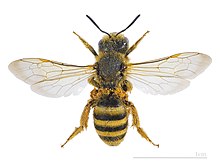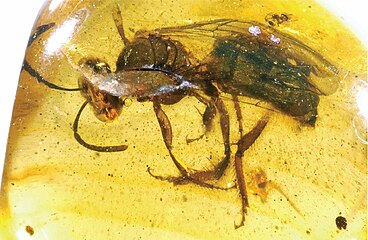| Halictidae | |
|---|---|

| |
| Halictus scabiosae - MHNT | |
| Scientific classification | |
| Domain: | Eukaryota |
| Kingdom: | Animalia |
| Phylum: | Arthropoda |
| Class: | Insecta |
| Order: | Hymenoptera |
| Clade: | Anthophila |
| Family: | Halictidae Thomson, 1869, nom. protect. |
| Subfamilies | |
Halictidae is the second-largest family of bees (clade Anthophila) with nearly 4,500 species. They are commonly called sweat bees (especially the smaller species), as they are often attracted to perspiration. Halictid species are an extremely diverse group that can vary greatly in appearance. These bees occur all over the world and are found on every continent except Antarctica. Usually dark-colored (frequently brown or black) and often metallic, halictids are found in various sizes, colors and patterns. Several species are all or partly green and a few are red, purple, or blue. A number of them have yellow markings, especially the males, which commonly have yellow faces, a pattern widespread among the various families of bees. The family is one of many with short tongues and is best distinguished by the arcuate (strongly curved) basal vein found on the wing. Females in this family tend to be larger than the males. They are the group for which the term 'eusocial' was first coined by entomologist, Suzanne Batra.
Ecology
Most halictids nest in the ground, often in habitats like clay soil and river banks, though a few nest in wood. They mass-provision their young; a mass of pollen and nectar is formed inside a waterproof cell, an egg laid upon it, and the cell sealed off, so the larva is given all of its food at one time, as opposed to "progressive provisioning", where a larva is fed repeatedly as it grows, as in honey bees. Some species line their tunnels with lactone secretions to help workers return to the nest. It is thought that each individual bee has its own unique chemical signature. All species (except for kleptoparasites) are pollen feeders and may be important pollinators.

Eusociality
Further information: EusocialityMany species in the Halictidae are eusocial at least in part, such as Lasioglossum malachurum, with fairly well-defined queen and worker castes (though not the same as the caste system in honey bees), and certain manifestations of their social behavior appear to be facultative in various lineages. The first group of offspring continues to build and protect the nest as well as gather food for a new brood of larvae. An impressive variety of social and nesting behaviors are exhibited by halictids including solitary, communal, semi-social and primitively eusocial. Different biotic and abiotic factors can even affect these behaviors such as floral resources, location, altitude, season, and climate.
Those species which do not have a permanent, rigid, division of labor, such as Lasioglossum zephyrus or Halictus rubicundus, are considered primitively eusocial. Another example of a primitive eusocial bee species from this family is Halictus ligatus, for which aggression is one of the most influential behavioral attitudes for establishing hierarchy and social organization within the colony. Primitively eusocial species such as these provide insight into the early evolution of eusociality. Halictus sexcinctus, which exhibits social, communal, and eusocial organization, provides insight into the evolutionary reversal of eusociality. Phylogenetic data from this species suggests that a communal strategy serves as a transitional step between eusociality and a reversion back to solitary nesting.
Kleptoparasitism
Several genera and species of halictids are kleptoparasites of other bees (mostly other halictids or bees of similar size). The behavior has evolved at least nine times independently within the family. The most well-known and common are species in the genus Sphecodes, which are somewhat wasp-like in appearance (often shining black with blood-red abdomen- German: Blutbienen - usually 4–9 mm in body length); the female Sphecodes enters the cell with the provision mass, eats the host egg, and lays an egg of her own in its place.
"Nocturnal" species
Halictidae is one of the four bee families that contain some crepuscular species; these halictids are active only at dusk or in the early evening, so are technically considered "vespertine" (e.g. in the subgenus Sphecodogastra of Lasioglossum), or sometimes truly nocturnal (e.g. in the genus Megalopta, such as the species M. genalis). These bees, as is typical in such cases, have greatly enlarged ocelli. The other families with some crepuscular species are Andrenidae, Colletidae, and Apidae.
Economic importance
Some Halictids are important in the pollination of crops. Among these are the alkali bee, Lasioglossum vierecki and Lasioglossum leucozonium. While some halictid species are oligoleges (e.g., Rophites algirus which only visits the flowers of hedgenettle plants.), most are generalists making them potentially valuable overall pollinators.
Stinging

Only females have the ability to deliver a sting. Due to their non-aggressive nature, they are only likely to sting if disturbed; the sting is minor. The most common instances of stinging occur from swatting at or accidentally making contact with a halictid trying to get a lick of one's sweat, seeking the dissolved electrolytes.
Phylogeny
Halictidae belongs to the hymenopteran subclade Aculeata (stinging Hymenoptera), superfamily Apoidea (bees and wasps), series Anthophila (true bees). Fossils from this family are typically found in amber from the Baltic Region and the Dominican Republic and imply that Halictidae have existed since at least 96-75 million years ago. The oldest fossil record of Halictidae dates back to Early Eocene with a number of species, such as Neocorynura electra and Augochlora leptoloba known from amber deposits. Currently, the family is divided into four subfamilies, many genera, and more than 2000 known species. Rophitinae appears to be the sister group to the remaining three subfamilies (Nomiinae, Nomioidinae, Halictinae) based on both morphology and molecular data.
-
 Agapostemon sp.
Agapostemon sp.
-
 Dufourea novaeangliae side
Dufourea novaeangliae side
-
 female Oligochlora semirugosa in Dominican amber of Miocene age
female Oligochlora semirugosa in Dominican amber of Miocene age
-
 Augochloropsis metallica male
Augochloropsis metallica male
- A pure green sweat bee foraging on yellow ironweed
Classification
Subfamily Rophitinae:
- Ceblurgus
- Conanthalictus
- Dufourea
- Goeletapis
- Micralictoides
- Morawitzella
- Morawitzia
- Penapis
- Protodufourea
- Rophites
- Sphecodosoma
- Systropha
- Xeralictus
Subfamily Nomiinae:
- Dieunomia
- Halictonomia
- Lipotriches
- Mellitidia
- Nomia
- Pseudapis
- Ptilonomia
- Reepenia
- Spatunomia
- Sphegocephala
- Steganomus
Subfamily Nomioidinae:
Subfamily Halictinae:
Tribe Halictini
- Agapostemon
- Caenohalictus
- Dinagapostemon
- Echthralictus
- Eupetersia
- Glossodialictus
- Habralictus
- Halictus
- Homalictus
- Lasioglossum
- Mexalictus
- Microsphecodes
- Nesosphecodes
- Paragapostemon
- Patellapis
- Pseudagapostemon
- Ptilocleptis
- Rhinetula
- Ruizantheda
- Sphecodes
- Thrincohalictus
- Urohalictus
Tribe Thrinchostomini
Tribe Augochlorini
- Andinaugochlora
- Ariphanarthra
- Augochlora
- Augochlorella
- Augochlorodes
- Augochloropsis
- Caenaugochlora
- Chlerogas
- Chlerogella
- Chlerogelloides
- Corynura
- Halictillus
- Ischnomelissa
- Megalopta
- Megaloptidia
- Megaloptilla
- Megommation
- Micrommation
- Neocorynura
- Paroxystoglossa
- Pseudaugochlora
- Rhectomia
- Rhinocorynura
- Temnosoma
- Thectochlora
- Xenochlora
Unplaced fossil halictines:
References
- Danforth, Bryan N.; Cardinal, Sophie; Praz, Christophe; Almeida, Eduardo A.B.; Michez, Denis (2013). "The Impact of Molecular Data on Our Understanding of Bee Phylogeny and Evolution". Annual Review of Entomology. 58 (1): 57–78. doi:10.1146/annurev-ento-120811-153633. PMID 22934982.
- ^ "Bee Diversity". Museum of the Earth. Retrieved 2021-12-06.
- "Sweat Bees". Missouri Department of Conservation. Archived from the original on 2015-09-26.
- ^ "Sweat bees". Florida Wildflower Foundation. 2017-08-15. Retrieved 2021-12-06.
- Bolt, Clay (16 June 2023). "Five myths about bees: The truth about these remarkable insects". World Wide Fund for Nature.
- ^ Hauze, Deena. "Halictidae (halictid bees, sweat bees)". Animal Diversity Web. Retrieved 2021-12-06.
- "sweat bees, halictid bees". Featured Creatures. University of Florida Entomology and Nematology Department. Retrieved 21 September 2019.
- Yanega, D. (1993-06-01). "Environmental influences on male production and social structure in Halictus rubicundus (Hymenoptera: Halictidae)". Insectes Sociaux. 40 (2): 169–180. doi:10.1007/BF01240705. ISSN 0020-1812. S2CID 44934383.
- Batra, Suzanne W. T. (1966). "The life cycle and behavior of the primitively social bee Lasioglossum zephyrum (Halictidae)". Univisty of Kansas Science Bulletin. 46: 359–423.
- ^ Pabalan, N.; Davey, K.G.; Packer, L. (2000). "Escalation of aggressive interactions during staged encounters in Halictus ligatus Say (Hymenoptera: Halictidae), with a comparison of circle tube behaviors with other halictine species". Journal of Insect Behavior. 13 (5): 627–650. doi:10.1023/a:1007868725551. S2CID 20773517.
- Richards, M. H. (2003). "Variable worker behaviour in the weakly eusocial sweat bee, Halictus sexcinctus Fabricius". Insectes Sociaux. 50 (4): 361–364. doi:10.1007/s00040-003-0691-3. S2CID 38716600.
- Greiner, Birgit; Ribi, Willi A.; Warrant, Eric J. (2004-04-03). "Retinal and optical adaptations for nocturnal vision in the halictid bee Megalopta genalis". Cell and Tissue Research. 316 (3): 377–390. doi:10.1007/s00441-004-0883-9. ISSN 0302-766X. PMID 15064946. S2CID 2155166.
- "A native ground nesting bee, Nomia melanderi, sustainably managed to pollinate alfalfa across an intensively agricultural landscape)". United States Department of Agriculture - Agricultural Research Service.
- Kuehn, F. (2015). "Farming for native bees: Final report". SARE - Sustainable agriculture research & education.
- Adamson, N. L. (2011). An assessment of non-Apis bees as fruit and vegetable crop pollinators in southwest Virginia (PDF) (PhD). Virginia Polytechnic Institute and State University.
- "Halictid Bees". www.fs.fed.us. Retrieved 2021-12-06.
- "StackPath". www.gardeningknowhow.com. Retrieved 2021-12-07.
- "No Need To Sweat Non-Aggressive Sweat Bees Or Lookalike Hover Flies". Forest Preserve District of Will County. Retrieved 2021-12-07.
- Engel, M.S.; Archibald, S.B. (2003). "An Early Eocene bee (Hymenoptera: Halictidae) from Quilchena, British Columbia". The Canadian Entomologist. 135 (1): 63–69. doi:10.4039/n02-030. hdl:1808/16473. S2CID 54053341.
- Engel, M.S. (1995). "Neocorynura electra, a New Fossil Bee Species from Dominican Amber (Hymenoptera:Halictidae)". Journal of the New York Entomological Society. 103 (3): 317–323. JSTOR 25010174.
- Engel, M.S. (2000). "Classification of the bee tribe Augochlorini (Hymenoptera, Halictidae)" (PDF). Bulletin of the American Museum of Natural History. 250: 1. doi:10.1206/0003-0090(2000)250<0001:COTBTA>2.0.CO;2. hdl:2246/1598. S2CID 85810077.
- Patiny, S.; et al. (2008). "Phylogenetic relationships and host-plant evolution within the basal clade of Halictidae (Hymenoptera, Apoidea)". Cladistics. 24 (3): 255–269. doi:10.1111/j.1096-0031.2007.00182.x. S2CID 23828602.
External links
- Family Halictidae Large format diagnostic photos, information.
- Everything About the Sweat Bee - Description and photo of the sweat bee.
- Image Gallery from Gembloux Archived 2016-03-03 at the Wayback Machine
- BugGuide – Search: Halictidae (North American species only).
- Online identification guides for eastern North American Halictidae
- Halictidae on the UF / IFAS Featured Creatures Web site
| Eusociality | ||
|---|---|---|
| Topics |  | |
| Groups | ||
| In culture | ||
| Pioneers, works |
| |
| Taxon identifiers | |
|---|---|
| Halictidae |
|